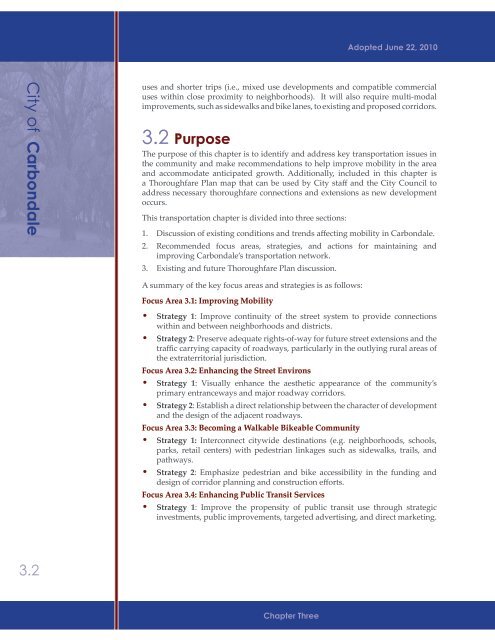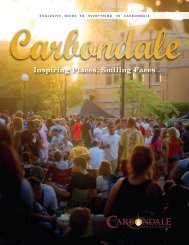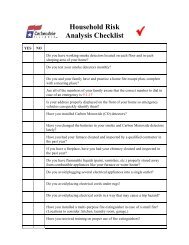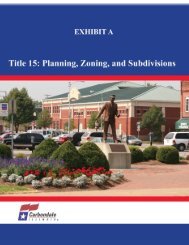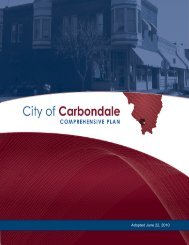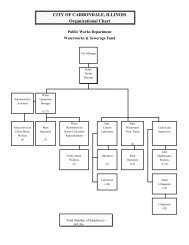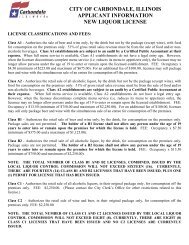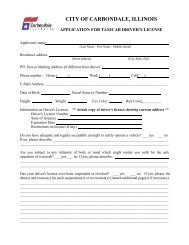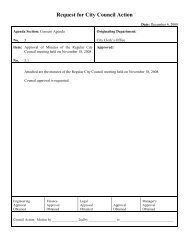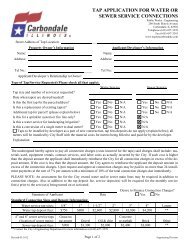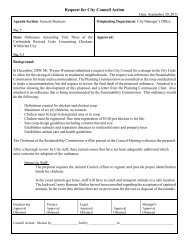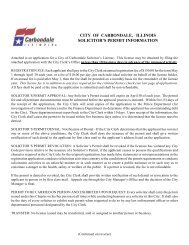Adopted June 22, 2010City of <strong>Carbondale</strong>uses and shorter trips (i.e., mixed use developments and compatible commercialuses within close proximity to neighborhoods). It will also require multi-modalimprovements, such as sidewalks and bike lanes, to existing and proposed corridors.3.2 PurposeThe purpose of this chapter is to identify and address key transportation issues inthe community and make recommendations to help improve mobility in the areaand accommodate anticipated growth. Additionally, included in this chapter isa Thoroughfare <strong>Plan</strong> map that can be used by City staff and the City Council toaddress necessary thoroughfare connections and extensions as new developmentoccurs.This transportation chapter is divided into three sections:1. Discussion of existing conditions and trends affecting mobility in <strong>Carbondale</strong>.2. Recommended focus areas, strategies, and actions for maintaining andimproving <strong>Carbondale</strong>’s transportation network.3. Existing and future Thoroughfare <strong>Plan</strong> discussion.A summary of the key focus areas and strategies is as follows:Focus Area 3.1: Improving Mobility• Strategy 1: Improve continuity of the street system to provide connectionswithin and between neighborhoods and districts.• Strategy 2: Preserve adequate rights-of-way for future street extensions and thetraffic carrying capacity of roadways, particularly in the outlying rural areas ofthe extraterritorial jurisdiction.Focus Area 3.2: Enhancing the Street Environs• Strategy 1: Visually enhance the aesthetic appearance of the community’sprimary entranceways and major roadway corridors.• Strategy 2: Establish a direct relationship between the character of developmentand the design of the adjacent roadways.Focus Area 3.3: Becoming a Walkable Bikeable Community• Strategy 1: Interconnect citywide destinations (e.g. neighborhoods, schools,parks, retail centers) with pedestrian linkages such as sidewalks, trails, andpathways.• Strategy 2: Emphasize pedestrian and bike accessibility in the funding anddesign of corridor planning and construction efforts.Focus Area 3.4: Enhancing Public Transit Services• Strategy 1: Improve the propensity of public transit use through strategicinvestments, public improvements, targeted advertising, and direct marketing.3.2Chapter Three
Adopted June 22, 20103.3 Existing ConditionsPedestrian and Bicyclist ConnectionsAs a university community, thereis an increased propensity forwalking and bicycling. This isespecially true on and aroundcampus, which itself has a denseweb of sidewalks and pathways,but also extends to many offcampusdestinations of studentliving, shopping, and recreation(see Figure 3.1, Proposed CampusMaster <strong>Plan</strong>). Moreover, based onthe community input received,there is a call by residents forimproved pedestrian connectionscitywide. A comprehensive trailand sidewalk system wouldbe for leisure and recreation,health and fitness, better accessto the community’s parks andnatural areas, and a consciouseffort to reduce vehicle trips andlessen the use of -- and relianceon – fossil fuels. In this way, theCity could take steps to fulfill itssustainability goals.Figure 3.1 | PROPOSED CAMPUS MASTER PLANPresently, there are neighborhoods Source: Southern Illinois Universitythat have a good network ofsidewalks (both within and around the periphery) and other neighborhoods thatdo not (see Map 3.1, Existing Sidewalk System). Improving walkability requiresthe design of walkable neighborhoods and seamless connections between them.Missing sidewalk links, unusable sections, and/or poor access and street crossingtreatments at intersections can make it easier to decide to drive rather than walk inthe interest of safety. Barriers like the railroad, major arterial highways like U.S.51 and <strong>IL</strong> 13, wide and busy intersections like that at Illinois/University/Mill, andnoncontiguous development must be overcome. In short, “pedestrianism” must beconsidered in all aspects of development and design if <strong>Carbondale</strong> is to improve itsattractiveness as a place to bicycle and walk.There are places within the community that are walkable from the perspective ofhaving stores, schools, and parks in close proximity to housing. While there maybe nearby conveniences to these locations, there are also obstacles and barriers towalking/bicycling that will require good planning and design solutions.Currently, the City has several on-street and off-street trails through the moredensely developed areas of the community as pictured in Figure 3.2, BikewayRoutes (see next page). However, they are not yet tied together in a comprehensivesystem of trails, sidewalks, and pathway connectors. Fortunately, there are several<strong>Comprehensive</strong> <strong>Plan</strong>3.3Community Mobility
- Page 1:
Adopted June 22, 2010
- Page 4 and 5:
Adopted June 22, 2010City of Carbon
- Page 6 and 7:
Adopted June 22, 2010City of Carbon
- Page 8 and 9:
Adopted June 22, 20101CommunityOver
- Page 10 and 11:
Adopted June 22, 2010validates many
- Page 12 and 13:
DemographicComparisonEducation% Pop
- Page 14 and 15:
Adopted June 22, 2010will remain st
- Page 16 and 17:
Adopted June 22, 2010factors for re
- Page 18 and 19:
Adopted June 22, 2010strategies, in
- Page 20 and 21:
Adopted June 22, 2010To facilitate
- Page 22 and 23:
Adopted June 22, 2010A priority-set
- Page 24 and 25:
Adopted June 22, 2010Infill Develop
- Page 26 and 27: Adopted June 22, 2010the community
- Page 28 and 29: 2Land Use CharacterAdopted June 22,
- Page 30 and 31: Adopted June 22, 2010• Strategy 3
- Page 32 and 33: Adopted June 22, 2010community char
- Page 34 and 35: Adopted June 22, 2010DesignationTab
- Page 36 and 37: Adopted June 22, 2010Summary of exi
- Page 38 and 39: Adopted June 22, 2010a priority (al
- Page 40 and 41: Adopted June 22, 2010Park Service A
- Page 42 and 43: Adopted June 22, 2010area (see Map
- Page 44 and 45: Adopted June 22, 2010environmental
- Page 46 and 47: Adopted June 22, 2010as a valuable
- Page 48 and 49: Adopted June 22, 2010c. Improve acc
- Page 50 and 51: Adopted June 22, 2010District / Dev
- Page 52 and 53: Adopted June 22, 2010Actions and In
- Page 54 and 55: Adopted June 22, 2010The “communi
- Page 56 and 57: Adopted June 22, 2010Actions and In
- Page 58 and 59: Adopted June 22, 2010building place
- Page 60 and 61: Adopted June 22, 2010during the lat
- Page 62 and 63: Adopted June 22, 2010Plan. This dis
- Page 64 and 65: Adopted June 22, 2010monotony by re
- Page 66 and 67: Adopted June 22, 2010g. Amend the c
- Page 68 and 69: Adopted June 22, 2010effective in a
- Page 70 and 71: AIRPORT RDService2.2ParkAreasPARKS
- Page 72 and 73: COUNTRY CLUB RDS. OAKLAND AVEMurphy
- Page 75: Adopted June 22, 20103CommunityMobi
- Page 79 and 80: Adopted June 22, 2010Existing Stree
- Page 81 and 82: Adopted June 22, 2010caused by turn
- Page 83 and 84: Adopted June 22, 2010secondary arte
- Page 85 and 86: Adopted June 22, 2010of traffic sig
- Page 87 and 88: Adopted June 22, 2010number and wid
- Page 89 and 90: Adopted June 22, 2010e. Coordinate
- Page 91 and 92: Adopted June 22, 2010STREETSCAPE MA
- Page 93 and 94: Adopted June 22, 2010c. Re-evaluate
- Page 95 and 96: Adopted June 22, 2010streets’ imp
- Page 97 and 98: Adopted June 22, 2010Downtown Carbo
- Page 99 and 100: COUNTRY CLUB RDN. BILLY BRYAN STS.
- Page 101 and 102: 3.3SalukiExpress RoutesTRANSIT ROUT
- Page 103 and 104: Adopted June 22, 20104Housing &Neig
- Page 105 and 106: Adopted June 22, 2010Summary of Hou
- Page 107 and 108: Adopted June 22, 2010the 1970’s.
- Page 109 and 110: Adopted June 22, 2010Figure 4.3 | O
- Page 111 and 112: Adopted June 22, 2010units. This su
- Page 113 and 114: Adopted June 22, 2010poverty, conve
- Page 115 and 116: Adopted June 22, 2010from increased
- Page 117 and 118: Adopted June 22, 2010Rationale:In s
- Page 119 and 120: Adopted June 22, 2010Strategy 2: Ut
- Page 121 and 122: Adopted June 22, 2010building orien
- Page 123 and 124: Adopted June 22, 2010Table 4.5Incom
- Page 125 and 126: Adopted June 22, 2010including publ
- Page 127 and 128:
COUNTRY CLUB RDN. MARION STBig Mudd
- Page 129 and 130:
Big Muddy R.104.03Big Muddy R.Crab
- Page 131 and 132:
COUNTRY CLUB RDN. MARION STMurphysb
- Page 133 and 134:
Adopted June 22, 2010City of Carbon
- Page 135 and 136:
Adopted June 22, 2010City of Carbon
- Page 137 and 138:
Adopted June 22, 2010City of Carbon
- Page 139 and 140:
Adopted June 22, 2010City of Carbon
- Page 141 and 142:
Adopted June 22, 2010City of Carbon
- Page 143 and 144:
Adopted June 22, 2010City of Carbon
- Page 145 and 146:
Adopted June 22, 2010City of Carbon
- Page 147 and 148:
Adopted June 22, 2010City of Carbon
- Page 149 and 150:
Adopted June 22, 2010City of Carbon
- Page 151 and 152:
Adopted June 22, 2010City of Carbon
- Page 153 and 154:
Adopted June 22, 2010City of Carbon
- Page 155 and 156:
Adopted June 22, 2010City of Carbon
- Page 157 and 158:
Adopted June 22, 2010City of Carbon
- Page 159 and 160:
Adopted June 22, 2010City of Carbon
- Page 161 and 162:
Adopted June 22, 2010City of Carbon
- Page 163 and 164:
Adopted June 22, 2010City of Carbon
- Page 165 and 166:
Adopted June 22, 2010City of Carbon


